Independent Surveyors solve problems
Our highly qualified independent surveyors will offer you advice on your property problems and can carry out a building survey for you on both residential or business properties. We also carry out many Specific Defect Reports on things such as cracking, dampness and condensation.
We are here to help you with all property matters. Please free phone us on 0800 298 5424 for a friendly chat with a surveyor.
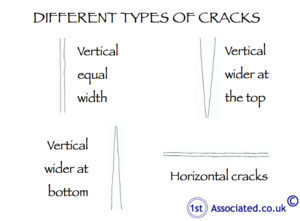
Different types of cracks
Cracks in your walls – what does it mean?
This article looks and considers cracks in plasterwork. Cracks are one of the most common reasons for people phoning us. Often the cracks can be something that they saw as they walked around a potential new house and home. However equally we have been called by people living in a property and they have noticed cracks occurring. We don't wish to be alarmist with regards to cracks as some cracks can simply be seasonal changes and variations in a house as you get what is known as differential movement when a houses components move at differential rates and cause cracks to a property. Below are a range of cracks that we have identified during structural surveys and building surveys that we have carried out. Some are barely noticeable in the photos but they have been identified by the red circles.
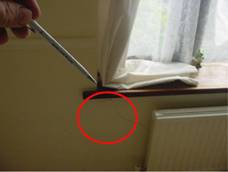
Crack below window
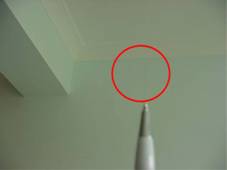
Vertical crack found near a lintel
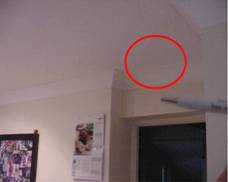
Crack over door
We, of course, record these during the survey. The question is are these cracks structural and a problem with the building resulting from settlement, subsidence or heave?
Settlement, Subsidence and Heave Defined
Clay expands and contracts, depending upon its moisture content. It is at its bulkiest at 40% to 60%, however, it changes form if it gets wetter or dryer. It is this change of its bulk that causes problems. When the clay soil gets too wet the clays bulk becomes larger and almost pushes the property out of the ground. This is known as heave. When the clay dries out it becomes dust like, then we get settlement of foundations and subsidence of the building, as its bulkiness has reduced considerably.
We use lots of sketches and photos in our building surveys
Before we go into too much detail about cracking we just need to say that we have written the article to show how we use lots of sketches and photos in our structural surveys and building surveys.
The feedback that we get from our clients is that they like our reports because we make them so clear and simple to understand because we write in plain English and don't over use technical terms, and we define terms when we do use them but most of all we use sketches and photos to help them understand the problems with the property. This in turn means that they can negotiate with the estate agent from a point of strength (remember the estate agents job is to sell the property and negotiate against the buyer) and what is more they can also explain to the builder what needs doing and believe it or not, lots of builders do require very detailed explanations about what they need to do.
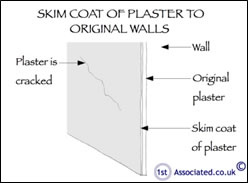
An example of one of our sketches
We would add that our reports have an Executive Summary which advises of the problems, these are divided into immediate problems where you need to take action, minor problems where something needs to happen and problems where you should walk away from the property. In addition to this we use the terms Action Required and Anticipated Cost to explain what you need to do, (sometimes we give options on this) and the likely cost. As mentioned, all of these are divided into a Priority list of problems which we call The Good, The Bad and The Ugly – because everyone remembers this.
What do the circles and ovals in our building surveys mean?
Basically they are they for you! We use circles and ovals on our photos and sketches where relevant throughout our building survey reports. This is just another tool we use to ensure we explain your property problems in the best way.
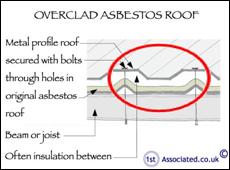
An example of one of our sketches
Plaster Everywhere
Plaster is one of those things that doesn't get noticed, it's just there. It doesn't get noticed except by good building surveyors carrying out good quality structural surveys and building surveys.
A good surveyor will be looking for signs of defects in the plaster indicating that there are problems in the structure as a whole but the cracks in plaster take many forms. It does need an experienced eye to understand exactly what cracks represent.
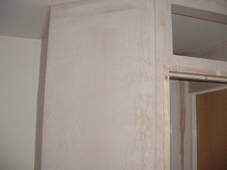
Close up of modern gypsum plaster
Do builders really know what they are talking about when they are looking at cracks in plaster?
We have been surprised over the years how many builders diagnosed cracks in plaster as just being cosmetic and saying the best way is to plaster over them (is this because they want the building work?) and equally we have seen builders carry out work without really understanding what they are doing.
This may be because of lack of knowledge or it may be because they are after work, we need to remember that a builder needs to build to make a profit, we simply don't know, but over the years we have been called out to homeowners and commercial property owners who have been concerned about cracks and listened to all sorts of stories as to how the builder thinks that the wall needs structural support or needs major work.
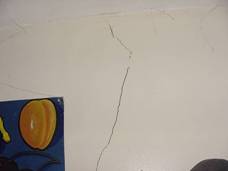
Cracking to internal wall
Are builders insured to comment on structural problems?
If the builder is so confident with regards to the work required, ask them to put in writing their recommendations and show that they are insured to comment on that sort of work. You will find that a few builders may do this, who will tend to be builders with specialist knowledge in this area, but generally they would refer you to a surveyor.
Reasons for cracks in plaster
First of all cracks can take many forms from what we will term a hairline crack, which is 1-2mm at the most to much larger cracks. In fact there are guidance notes on how to describe such cracks that are used by Structural Engineers and Building Surveyors. Without wishing to get too technical we will stick to hairline cracks, structural cracks and non-structural cracks.

Different types of cracks
Hairline Cracking
Hairline cracking is often due to a skim coat of modern plaster being put over an old lime plaster. This together with the general dampness in a property due to factors such as:
1. Dampness getting in via the poor detailing on the roof and to the chimneys.
2 Dampness via the walls where work is needed.

Skim coat of plaster to original walls
3. Dampness via a sloping site into a suspended timber floor.
4 There may be other additional contributing factors such as nearby trees.
The above factors combined create a dampish building which due to the skim coat of modern gypsum plaster is very visible in a property.
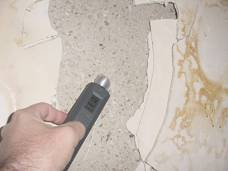
Damp to mix of lime plaster and
gypsum plaster
Old Lime Plasters
Whilst modern plasters and old plasters can look very similar they behave very differently. An old plaster is likely to have a largish lime content and is what should be used on older properties as it then means the walls are breathable which will reduce / remove any dampness in them. It should be remembered that an older property will never be absolutely free of dampness in the walls as it was constructed to have some dampness in it and this will then dissipate over time with the breathableness of the walls.
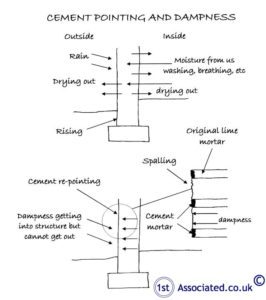
Cement pointing and dampness
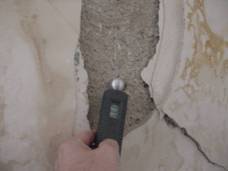
Lime plaster with gypsum skim plaster
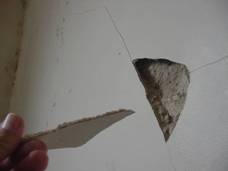
Old and new plaster going
separate ways
Old plaster falling off the walls
Many people buy an old property and find that the plaster is hollow and literally falling off the walls. This is often due to dampness in the structure that has been allowed to, for many years, penetrate inside the property. We think it also may have something to do with the warmer inside climate drawing the dampness in. This has then meant that the plaster has lost its grip or key on the wall and formed a blister behind the plaster for want of a better term. This is known as blown or hollow areas of plaster and is said to have lost its key.
Often the answer when you speak to a plasterer, as you would imagine, is that it needs replastering. We have also come across some instances where it is better to use a lining paper than to replaster particularly if the plasterer only knows how to plaster in a modern gypsum plaster when the property is an old property and should have lime mortar.
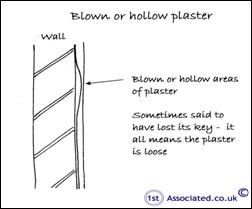
Cement pointing and dampness
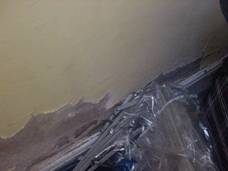
Here we can see what looks like
quite nice plaster at the top
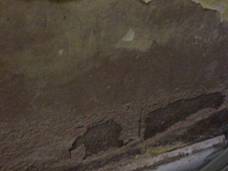
You can see there has been a skim
coat of plaster which can hide
almost anything
Modern Plasters
Modern plasters just can't compare and compete with older lime plasters however we use them because they are cheap and quick (where have we heard this in the building industry before!). As such, the skilful tradesmen that use old lime plaster tend to disappear.
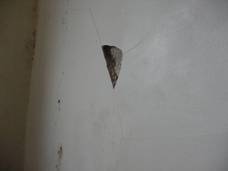
Skim gypsum plaster
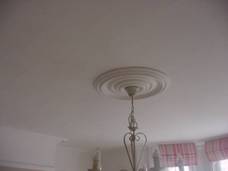
Skimmed ceiling
Dot and dab plasterboard man
Something that is very common is something that is known as dot and dab plastering. This is literally where many dots of plaster are applied to a wall and these are then flattened out by plasterboard being bedded against them to create what is known as a dry lined wall or a false wall. Most modern houses are constructed in this way which does add an extra layer of insulation.
It is also quick as there isn't the same sort of drying time that we have with a modern gypsum plaster.
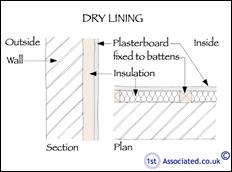
Dry lining
Dry lining is usually used on solid walls, particularly where dampness is occurring it can be used to hide the dampness. In older properties, where the internal wall is not flush, battens would be added and then lath and plaster.
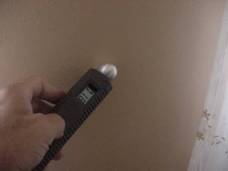
Check for lateral dampness not
possible due to dry lining
The following articles may be of interest to you:
Cracks to my plaster, is it a structural problem?
Structural Cracking
Compare Surveys, why ours are better than the competition
Have you ever seen a good modern gypsum plasterer at work? They can hide cracks very easily, they can even put a skim coat of plaster over the entire wall to hide them
A good plasterer can really change how a property looks. We have been so impressed by some plasterers in the past that we thought it would be a good idea just to leave the plaster finish however most of the homeowners that we dealt with didn't!

Close up of modern gypsum plaster
– you can almost see a grain in the
plaster
Here are a few examples of how good plaster can look (in our opinion). We must remind you that a modern gypsum plaster simply can't cope with dampness in the same way as an old lime plaster. In this instance the photos we are showing you are of a studwork wall which has been plasterboarded and then the joints taped and a skimcoat of plaster added.
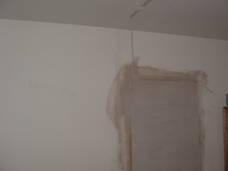
Plastering after a door has been
closed off
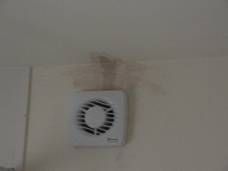
Making good around a humidity
control thermostat fan
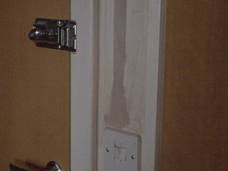
Plastering following re-wiring
Does modern plaster last as well as old plaster?
We were quite surprised recently when one of our trainee surveyors said to us that they had noticed how some of the modern houses in the properties that we manage were not lasting as long as some of the older properties that were plastered in the older style lime plaster. This was great to hear from a young surveyor who noticed, even in his short time of surveying of around three years, that modern plaster has to be looked after a lot more than older plaster. It certainly doesn't take use and abuse in the same way.
Meet our building surveyor at the property
We recommend that should you decide to have a building survey with us you meet us at the property during the survey to discuss further any issues such as cracking you have and also for us to show you what we have found. Please free phone us on 0800 298 5424 for a friendly chat with one of our surveyors.
Our surveying articles
We hope you found the article of use and if you have any experiences that you feel should be added to this article that would benefit others, or you feel that some of the information that we have put is wrong then please do not hesitate to contact us (we are only human).
The contents of the website are for general information only and are not intended to be relied upon for specific or general decisions. Appropriate independent professional advice should be paid for before making such a decision.
Commercial Property Surveyors
If you have a commercial property, whether it is freehold or leasehold then sooner or later you may get involved with dilapidation claims. You may wish to look at our Dilapidations Website at www.DilapsHelp.com and for Disputes go to our Disputes Help site www.DisputesHelp.com .
All rights reserved by 1stAssociated.co.uk
All rights are reserved the contents of the website are not to be reproduced or transmitted in any form in whole or part without the express written permission of www.1stAssociated.com

